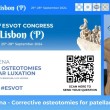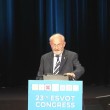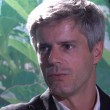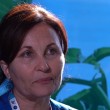Fredrik Danielsson
DVM, Spec.komp HK, Spec kir HK, Dipl ECVS
Consultant - Vet Aid AB
Sperlingev. 9
252 85 Helsingborg
Sweden
As a student I initiated and was very active in raising money and building a new ‘veterinary-house’ and after graduation 1989 I started working at Lundabygdens Djursjukhus and later at Regiondjursjukhus Helsingborg, both in southern Sweden. But after becoming Diplomate ECVS in year 2000 I offered a position as lecturer at Massey University, New Zealand. A year later, I got the opportunity to return to Regiondjursjukhuset Helsingborg, but now as leader of the small animal department. Then five years ago, 1997, I started a business, Vet Aid AB, with the mission to assist veterinary hospitals with education and clinical surgery. It has been working very well and I’m currently supervising two veterinarians at Blue Star Animal Hospital in Gothenburg for a specialty program in surgery. I also do clinical work and research there and at Lundabygdens Djursjukhus.
Having experienced the VOS meeting and knowing about other orthopaedic societies I got and idea and invited some of the leading veterinary surgeons in the Nordic countries. Together we formed NOVOS, Nordic Veterinary Orthopaedic Society. It has created a good opportunity to meet across boarders and exchange knowledge and experiences, arrange lectures and even published an article about arthroscopy.
I have hade the privileged to get involved in lecturing at different courses and most recently for AOVet in Cape Town. I’m also elected member of the AOVet European Board.
G.S-S. Do you recall a time on your childhood when you decided that you wanted to be a veterinarian or dud you want to be an engine driver and the idea od being a veterinarian came later?
F.D. As a child I actually wanted to be an architect and loved to draw houses. I still like architecture, but I would probably have not been very successful as an architect! I loved animals and had dogs, gunnies pigs and several aquariums, but I didn’t really think about becoming a veterinarian until it was time when I had to make a choice.
G.S-S. Did any particular instructor influence you education at the veterinary? If affirmative di that individual point you in the direction of orthopaedics, or did you become interested in bone and bones after graduating?
F.D. I actually ’knew’ when I started the veterinary school that I wanted to become a surgeon so I had that on my mind during the studies. I even participated in some post-graduate courses in surgery before I graduated. So, yes, I was rather focused on the idea of working with surgery. During my studies I was fortunate to work at a great animal hospital as technician during breaks and that boosted my interest for surgery! Later when I had graduated I was able to visit Prof. Ken Johnson at Univ Wisconsin, Peter Schwarz at CSU and Jim Boulay at Angell Memorial Animal Hospital, Lennart Sjöström at Strömsholm and they all inspired me to continue to make progress in veterinary orthopeadic surgery. I believe good mentors are exceptionally important for young ambitious veterinarians!
G.S-S. Can you you please tell readers about any particlar contrbutiona that you have made to the subeject: a technique or a discovery of which you are particlularly proud?
F.D. I’m afraid I haven’t made any revolutionary scientific contribution. I looked at the outcome of a large number of dogs with lumbosacral stenosis and showed a good respons with surgery. Furthermore, I was rather early with arthroscopy and started doing it I think in 1996. Hopefully by showing its possiblilties it helped others to also start doing arthroscopy and today of course it’s a very common technique
G.S-S. Do you have any special plans for the future regarding orthopaedics or yourself?
F.D. I’m involved in some clinical studies using a pressure mattress to evaluate the result of different surgical techniques from joint surgery and from laminectomies. I’m also involved in an exiting clinical study with joint cartilage plasty.
















